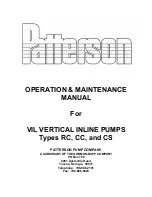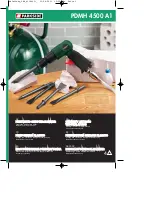
WARNING!
When using mains-powered tools, basic safety precautions, including the
following, should always be followed to reduce risk of fire, electric shock, personal injury
and material damage.
Read the whole manual carefully and make sure you know how to switch the tool off in an emergency, before operating the tool.
Save these instructions and other documents supplied with this tool for future reference.
The electric motor has been designed for DC (18V) motor and AC (230-240V) motor only. The charger has been designed for 230V and
240V only. Always check that the power supply corresponds to the voltage on the rating plate.
Note: The supply of 230V and 240V on Ozito tools are interchangeable for Australia and New Zealand.
If the supply cord is damaged, it must be replaced by an electrician or a power tool repairer in order to avoid a hazard.
This tool is double insulated therefore no earth wire is required.
Note:
Double insulation does not take the place of normal safety precautions when operating this tool. The insulation system is for
added protection against injury resulting from a possible electrical insulation failure within the tool.
Using an Extension Lead
Always use an approved extension lead suitable for the power input of this tool. Before use, inspect the extension lead for signs of
damage, wear and ageing. Replace the extension lead if damaged or defective.
When using an extension lead on a reel, always unwind the lead completely. Use of an extension lead not suitable for the power
input of the tool or which is damaged or defective may result in a risk of fire and electric shock.
The power supply for this products 240V power cord should be protected by a residual current device (rated at 30mA or less). A
residual current device reduces the risk of electric shock.
GENERAL POWER TOOL SAFETY WARNINGS
ELECTRICAL SAFETY
WARNING!
Read all safety warnings and all instructions.
Failure to follow the warnings and
instructions may result in electric shock, fire and/or serious injury.
Save all warnings and instructions for future reference. The term “power tool” in the warnings
refers to your mains-operated (corded) power tool or battery-operated (cordless) power tool.
1. Work area safety
a.
Keep work area clean and well lit
. Cluttered or dark areas invite accidents.
b.
Do not operate power tools in explosive atmospheres, such as in the presence of flammable
liquids, gases or dust.
Power tools create sparks which may ignite the dust or fumes.
c.
Keep children and bystanders away while operating a power tool.
Distractions can cause you to lose
control.
2. Electrical safety
a.
Power tool plugs must match the outlet. Never modify the plug in any way. Do not use any
adapter plugs with earthed (grounded) power tools.
Unmodified plugs and matching outlets will reduce risk
of electric shock.
b.
Avoid body contact with earthed or grounded surfaces, such as pipes, radiators, ranges and
refrigerators.
There is an increased risk of electric shock if your body is earthed or grounded.
c.
Do not expose power tools to rain or wet conditions.
Water entering a power tool will increase the risk of
electric shock.
d.
Do not abuse the cord. Never use the cord for carrying, pulling or unplugging the power tool.
Keep cord away from heat, oil, sharp edges or moving parts.
Damaged or entangled cords increase the
risk of electric shock.
e.
When operating a power tool outdoors, use an extension cord suitable for outdoor use.
Use of
a cord suitable for outdoor use reduces the risk of electric shock.
f.
If operating a power tool in a damp location is unavoidable, use a residual current device
(RCD) protected supply.
Use of an RCD reduces the risk of electric shock.
3. Personal safety
a.
Stay alert, watch what you are doing and use common sense when operating a power tool.
Do not use a power tool while you are tired or under the influence of drugs, alcohol or
medication.
A moment of inattention while operating power tools may result in serious personal injury.
b.
Use personal protective equipment. Always wear eye protection.
Protective equipment such as dust
mask, non-skid safety shoes, hard hat, or hearing protection used for appropriate conditions will reduce personal injuries.
c.
Prevent unintentional starting. Ensure the switch is in the off-position before connecting to
power source and/or battery pack, picking up or carrying the tool.
Carrying power tools with your
finger on the switch or energising power tools that have the switch on invites accidents.
d.
Remove any adjusting key or wrench before turning the power tool on.
A wrench or a key left
attached to a rotating part of the power tool may result in personal injury.
e.
Do not overreach. Keep proper footing and balance at all times.
This enables better control of the
power tool in unexpected situations.
f.
Dress properly. Do not wear loose clothing or jewellery. Keep your hair, clothing and gloves
away from moving parts.
Loose clothes, jewellery or long hair can be caught in moving parts.
g.
If devices are provided for the connection of dust extraction and collection facilities, ensure
these are connected and properly used.
Use of dust collection can reduce dust-related hazards.
4. Power tool use and care
a.
Do not force the power tool. Use the correct power tool for your application.
The correct power
tool will do the job better and safer at the rate for which it was designed.
b.
Do not use the power tool if the switch does not turn it on and off.
Any power tool that cannot be
controlled with the switch is dangerous and must be repaired.
c.
Disconnect the plug from the power source and/or the battery pack from the power tool
before making any adjustments, changing accessories, or storing power tools.
Such preventive
safety measures reduce the risk of starting the power tool accidentally.
d.
Store idle power tools out of the reach of children and do not allow persons unfamiliar with
the power tool or these instructions to operate the power tool.
Power tools are dangerous in the hands
of untrained users.
e.
Maintain power tools. Check for misalignment or binding of moving parts, breakage of parts
and any other condition that may affect the power tool’s operation. If damaged, have the
power tool repaired before use.
Many accidents are caused by poorly maintained power tools.
f.
Keep cutting tools sharp and clean.
Properly maintained cutting tools with sharp cutting edges are less likely to
bind and are easier to control.
g.
Use the power tool, accessories and tool bits etc. in accordance with these instructions,
taking into account the working conditions and the work to be performed.
Use of the power tool for
operations different from those intended could result in a hazardous situation.
5. Battery tool use and care
a.
Recharge only with the charger specified by the manufacturer.
A charger that is suitable for one type of
battery pack may create a risk of fire when used with another battery pack.
b.
Use power tools only with specifically designated battery packs.
Use of any other battery packs may
create a risk of injury and fire.
c.
When battery pack is not in use, keep it away from other metal objects, like paper clips,
coins, keys, nails, screws or other small metal objects, that can make a connection from one
terminal to another.
Shorting the battery terminals together may cause burns or a fire.
d.
Under abusive conditions, liquid may be ejected from the battery; avoid contact. If contact
accidentally occurs, flush with water. If liquid contacts eyes, additionally seek medical help.
Liquid ejected from the battery may cause irritation or burns.
6. Service
a.
Have your power tool serviced by a qualified repair person using only identical replacement
parts.
This will ensure that the safety of the power tool is maintained.
INFLATOR / DEFLATOR SAFETY WARNINGS
WARNING!
We cannot accept any liability for damage or accidents which arise due to a failure to follow these instructions and the
safety information.
This appliance is not intended for
use by persons (including children) with reduced physical, sensory or mental
capabilities, or lack of experience and knowledge, unless they have been given supervision or instruction concerning use of
the appliance by a person responsible for their safety.
• Do not aim the hose at other persons or animals.
• Always switch the unit off before changing attachments, filters and emptying the tank.
• When using the inflator to inflate car tyres, ensure you are parked in a safe, well lit location, off the road and with the
hand brake engaged.
• Ensure your personal safety is not at risk and never use the inflator while the car is in motion.
• Do not place the hose end against any part of your body when turned on, as this may infuse air into your blood stream
putting your health at serious risk.
• Do not make any alterations to this inflator. Only use the adaptors supplied with this product.
• Use this product only in accordance with operation instructions included in this manual.
• Inspect each part before use. Do not use if bent, broken, melted, burnt or if the unit appears to be damaged.
• Check the tyre pressure before inflating. Never exceed the suggested pressure of the item being inflated. If suggested
pressure is exceeded, the item being inflated may burst.
• Do not bend or pinch the air hose while the inflator is in use.
• It is not suggested that the inflator work continuously for more than 10 minutes. If 10 minutes of use has been
reached, turn it off and let it cool for 10 minutes before using again.
• If the inflator is making abnormal sounds or its temperature if quite high, switch the unit off straight away and let it
cool for at least 10 minutes before trying again. Improper use may result in damage of the Compressor.
• Do not leave unattended and operating. Keep out of reach of children.
• Put the inflator in a dry place if it is not in use for an extended period of time.
• Keep the inflator away from flammable liquid or gas. Do not allow the inflator to become wet.
• Never put the connector and adaptors into your mouth, ear or eye. They are not toys.


























